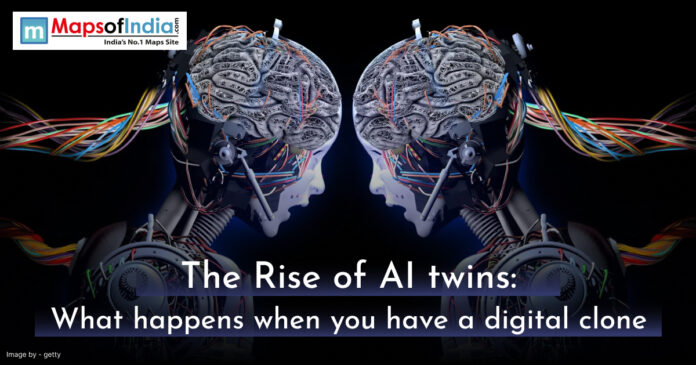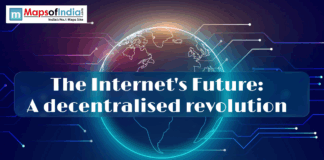AI twins are transforming human relationships with technology. These digital clones are used to replicate human behaviour such as preferences and decision making patterns with exact accuracy. They are powered by advanced artificial intelligence. They learn from vast datasets present online to act as proxies in personal and professional settings. AI twins are no longer futuristic fantasies. These are the practical tools that are integrated into our daily lives. They manage tasks. Streamline our work and even simulate our conversations. But their rise has sparked profound questions about our data privacy with ethics and identity.
Defining AI Twins
AI twins are sophisticated digital replicas of individuals. They use AI to mirror a person’s behaviour such as speech and choices. These are built using extensive personal data. This digital form reflects how a person thinks and acts in real life situations. For this the data provided is taken from our emails, personal texts and social media activity. They also utilize our browsing history. AI twins are used to schedule meetings and respond to messages. They can also use it to make recommendations. Now a days companies like xAI and others will lead their development. These technologies operate on secure cloud platforms. They are syncing with smartphones and IoT devices. Their purpose is to boost efficiency and save time. But at the end of the day they’re tools that work by algorithms. Their accuracy depends on what data we give them. Wrong design or incorrect data can lead to errors. Understanding their scope and limits is essential for making proper use.
The Technology Behind AI Twins
Creating an AI twin is an excellent technical achievement. It starts with comprehensive data collection. Those who want to participate voluntarily share their data like texts, emails, and social media posts. Voice recordings are used to capture speech patterns. Wearable devices add health and location data. Machine learning models are used to process this information. They identify behavioural trends and preferences. Natural language processing (NLP) enables lifelike dialogue. Generative AI which is built on large language models are used to craft realistic responses. Voice synthesis is used to replicate a user’s tone. Edge computing is used to ensure proper processing which gives smooth interactions. Encryption and blockchain keep our data securely stored. But there are still some challenges that exist. Incomplete or biased data can create a fake AI clone. Consent must be used before creating a clone. Cybersecurity is critical to essential data breaches. Users must be given all information regarding clone development.
Everyday Applications of AI Twins
AI twins are reshaping our daily routines. These twins act as our own efficient personal assistants. They manage calendars and make appointments. In smart homes AI clones are used to control household appliances. They do daily household chores according to a set time. In the healthcare sector AI twins monitor individual health through devices. If any problem arises they alert doctors. Some twins act as companions for elderly or isolated people engaging in conversation on a personal level. Some apps have integrated AI clones in devices like smartwatches and smartphones. They suggest things according to users’ preferences. But overreliance on these clones risks detachment from real connections. Human connections must remain central.
Transforming Professional Environments
AI twins are also revolutionizing workplaces. They automate repetitive tasks in the workplace like freeing employees for creative and strategic work. In 2025 many industries have embraced twins. There are many uses in workplaces from analyzing datasets to predicting market trends. And can also be used to generate reports. They can be used to boost productivity and efficiency in workplaces. But risks emerge. Overreliance on AI can cloud human judgment. Job roles may shift demanding new skills. The old workforce needs training to collaborate with AI. Companies must define clear boundaries of AI use. Twins should augment human expertise and not replace it. Thoughtful integration ensures sustainable benefits.
Ethical and Privacy Concerns
AI twins are raising some ethical challenges. Privacy is a primary concern. To develop AI twins they require access to sensitive data such as text and emails. They also need health records and location history. A single breach in a company could expose intimate details. Regulations like GDPR in Europe and CCPA in California set strict standards. But global companies are not bound by nations. Users often skim consent forms. Unaware of data scope. Still ethical questions remain. Who is responsible if a twin makes a harmful decision? Can twins influence user choices subtly? Bias in training data risks unfair outcomes. Biased datasets could lead to discriminatory recommendations. Regular audits and ethical guidelines to prevent misuse.
Psychological and Social Impacts
AI twins impact our mental and social well-being. They are useful to reduce stress by handling tasks. A twin scheduling appointments or managing emails saves mental energy. But they can blur personal identity. Seeing a digital clone act independently feels unsettling. A psychological study found that increased anxiety among heavy use. Some fear losing control over their digital selves. On the other hand others feel empowered by the efficiency. There are also some social risks. Twins AI can’t replicate the genuine human connection we build. Overuse of this technology may lead to isolation from society. Especially for those relying on twins for companionship. Experts recommend boundaries. Social interactions must take priority. Balance is key to healthy integration.
The Future Trajectory of AI Twins
The future of AI twins is full of excitement. But on the other hand things are uncertain. In the coming year they could be used in every household. Advancements in generative AI will make AI clones more accurate. Quantum computing will accelerate data processing. Making it easier to complete complex tasks. It might be used to predict diseases by analyzing genetic and previous data. They can also be used to create personalized learning paths according to one’s needs. Businesses may use AI clones and reduce the human workforce. But challenges still exist. Privacy laws must become stricter to protect users. Ethical frameworks need clarity to address autonomy and liability. AI twins promise many benefits in future. The user should ensure that it aligns with human values.
Conclusion
AI twins have marked a new era of human civilization. AI twins are now being used to manage our daily tasks. They are making work easier in workplaces. They are now being used for managing schedules to predicting health risks. Their potential is vast. But they come with risks. Privacy breaches are the main concern. Psychological impacts on the human mind need to be studied. AI twins are powerful tools. But not their separate beings. Their growth depends on regulation and transparency. They can magnify human potential but must not overshadow humans. Society must guide their development with care. The future rests on our choices.





